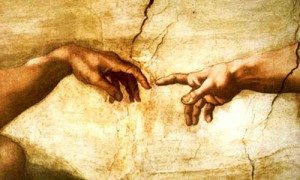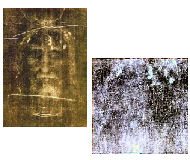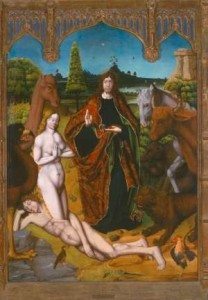By Zhenya Gershman, artist, educator and LuxEco Advocate
Christianity always stood in opposition to science. Copernicus – blasphemy, Mendel – blasphemy, Darwin – blasphemy! The first human quest for knowledge was severely punished by marching Adam out of heaven together with his sinful companion. The whole idea of religion is based on unconditional belief and not on tangible proof. Thus the very probing of science to break through the “cloud of unknowing” was a threatening and therefore sinful act. Why? Why would it be a disaster to get a little closer to the knowledge of how it all works? Curiously enough, there are other religions that operate under a similar belief system of guarding their God away from the human desire to know and see.* Both in Islamic and Judaic traditions, it is unthinkable to paint or to have any kind of representation of divinity. So much so that in the Hebrew language, one cannot even say the word “God”. In this case, even the word is criminal, let alone a genome project.
A seemingly unrelated fact number one is the Shroud of Turin. Fought over between the Catholic Church and scientific laboratories, this old piece of cloth remains a mystery. Is the negative image a clever trick of a painter or a holy imprint of Christ’s body? There is no distinct answer. However, attempts for chemical analysis were made, while the Catholics were simply appalled by the limits of human disbelief.
A popular position is: “Why do I need proof?” Well, fortunately or not, the human being is designed with a yearning need for knowledge. Any of us who have been exposed to kids know how many times they repeat the question “Why?” And how many times we don’t know how to answer. For instance, even the ‘simplest’ one of all, “Why are we here?” If we look at the biblical tale of Adam and Eve, it follows that the human being was designed to want to know. And even if he/she was ignorant to ask, then he/she was insistently given hints – “Have all you want but don’t go near that tree!”** Well, we did taste the apple, and so now we are faced with such moral questions as “Is it ethical to make a human clone?” Personally, I don’t take any sides, but simply think that it is unavoidable – just as it was unavoidable for Adam or Eve to taste from the forbidden fruit.***
Back to the Holy Shroud. Recently I was watching a Russian documentary which definitely had some moral undertones toward the side of “do not”. It was pretty much a traditional argument. However, at the very end, they interviewed a priest who declared with fear in his eyes that scientists are discussing the use of a drop of blood found on the Shroud of Turin (you might even have guessed whose DNA we are talking about) for their evil experiments with cloning. A shocking thought – to clone Christ!
A seemingly unrelated fact number two is that the insistence of the return of the prophet suddenly becomes very potent. We together as a society at large are expecting: Christ, Messiah, Mohammed, and a number of other prophets. Most religions believe that this would signify the end of the world; the small detail they don’t agree on is who will be saved. Jews believe they will be the ones, Christians would feel quite the opposite – in short, nobody wants to share the pie. Here I come to my main point. Assuming that it is Christ’s blood on the Shroud of Turin, the cloning, then, is the Second Coming. This would explain the subconscious fear carried out by religious dogma against science. The choice is clear – either you believe and you’ll live or you know and you’ll die. I am sure one can study the signs mentioned in the holy texts that are supposed to warn us about the second coming and apply them to contemporary life. Things like “Watch out for a red beast” – maybe it’s the cloned celebrity sheep Dolly, etc. What is interesting is that we have been told to behave, and if we don’t, we should expect the return of the savior [this time the fatal one]. We were warned once, at which time Christ took the suffering upon himself. However, according to the scripture, we should not be forgiven twice. When one thinks of the second coming, one imagines the story repeating itself with miraculous things like “the Annunciation” and all the rest of the attributes. But we don’t expect that it is we ourselves who would make it happen (not through an Immaculate Conception but by means of scientific fact and laboratory experiment). By the way, this gives a new perspective to the creation of Eve (cloned from Adams rib) and to the Divine Birth itself. Mysteries such as “how do you remain a virgin after conceiving a child” can then be solved.
True, we do suspect that even if the clone were genetically identical to its original, the character of the person would still be different, since it is conditioned by the environment. Therefore, we do not know if Christ will be as we know him or as an Anti-Christ. By any chance, if the drop of blood does not belong to God’s son but to an ingenious artist, then the meaning of eternalization by a work of art will definitely be seen in a new light. And how well deserved would be the rebirth of this artist!
Even if all of this is complete speculation, you can imagine what a great hit it would make as a film in Hollywood. The visual effects in the scenes of the Last Judgment alone… the only problem, there would be no sequel.
Extra Notes:
*Note the ancient fury of Pagan God Zeus at the famous “fire robbery.”
**Just in case, God let his former employee remind Adam and Eve again and again about it, even if only by naming him a “fallen angel.”
***Notice even this expression carries out a suggestion – eat me. If you want someone to do something, surely the fastest way to achieve that is to tell them not to.
ARTsmART:
Our world is reflected by Art and Art makes us reflect on the world. Delivered to you by an artist and educator, ARTsmART is a column dedicated to various art related topics that are food for thought. With hope to raise your appetite without having to watch your calories!!!
About the Columnist:
Zhenya Gershman was born in Moscow, Russia, where she took her apprenticeship from two famous academic painters, Orest Vereiski and Leonid Saiphertis. Zhenya held her first solo exhibition at the age of 14 in St. Petersburg, Russia. After moving to Los Angeles, she obtained her Bachelor’s of Fine Arts with honors from Otis Art Institute and a Master’s of Fine Arts from Art Center College of Design. Zhenya is an exhibiting artist, nationally and internationally, with shows including Bergamot Station, Los Angeles County Museum of Art, Jan Baum Gallery and other prestigious venues. Her work is displayed in private and public collections such as those of Michael and Katherine Dukakis, Donald and Judy Simon, and Richard Weisman. She is a recipient of numerous awards including the ALEX Award in Visual Arts, presented nationally to honored scholars and artists for excellence. Since 2001, she has been a full time educator at the J. Paul Getty Museum where she is a Project Specialist for Adult Gallery Programs. Apart from working in her studio and teaching, Zhenya has also produced and directed a multimedia stage film presentation starring Rene Russo entitled “Bonus Time” that premiered at Schoenberg Theater, benefiting UCLA’s Neuro-Oncology Department. You can read her interview with Spraygrahic.com and Watch her give a tour at the Getty Museum for the Sinai Exhibit.
















